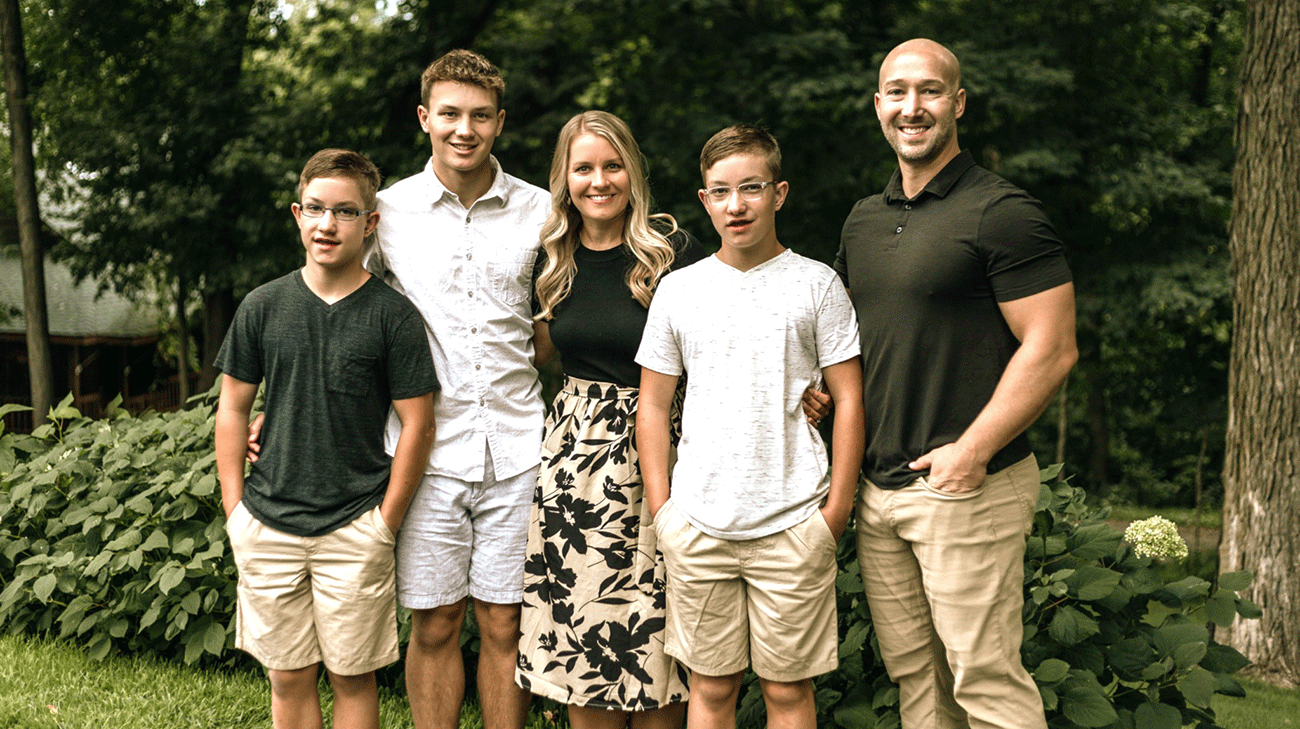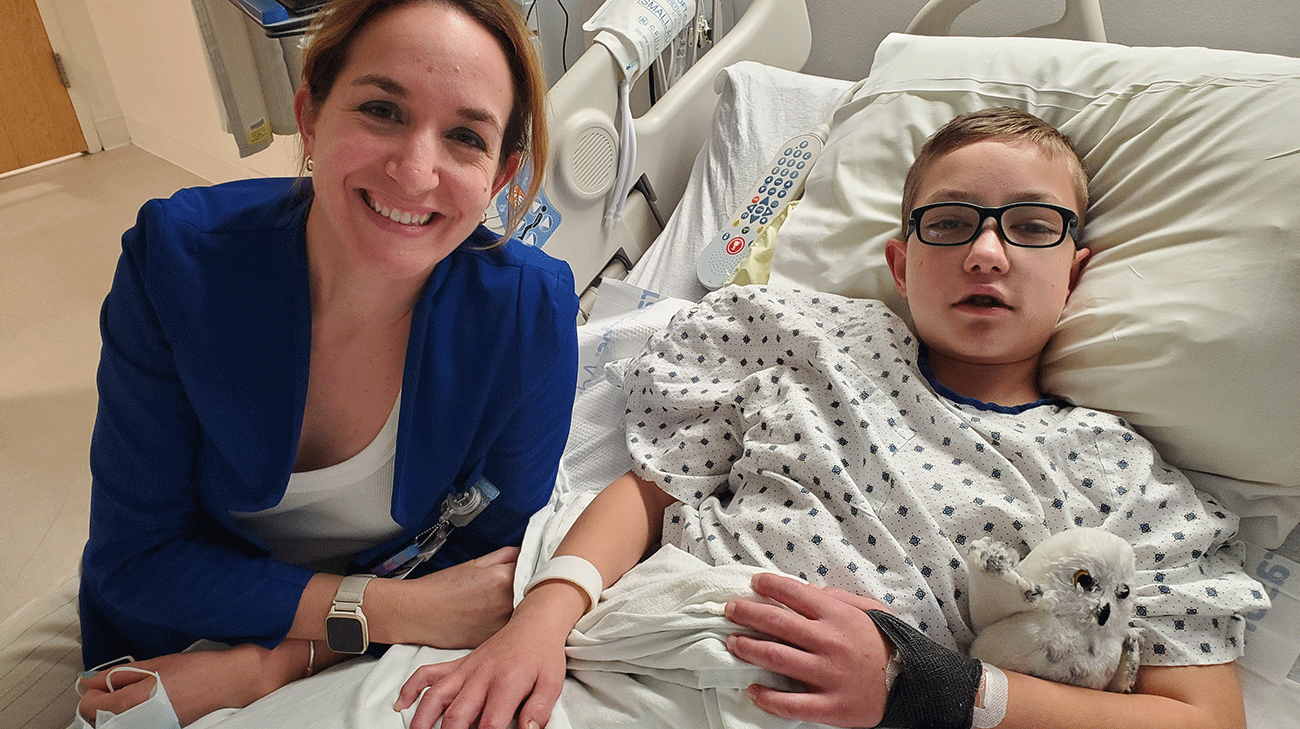
The Hoffman family (left to right): Owen, LeVi, Olivia, Noah and Luke. Photo courtesy of: Susie Townsend
In 2020, when Noah Hoffman was 7 years old, he was diagnosed with a kidney blockage. Imaging revealed an hourglass-shaped ureter draining his right kidney. Noah also has a rare genetic condition called Bardet-Biedl syndrome (BBS). “Both he and his twin have BBS,” says Noah’s mother, Olivia. However, his twin, Owen, does not have a horseshoe kidney. Once the horseshoe kidney and kidney blockage were discovered, a nephrologist continued to monitor Noah’s condition. When he was 11 years old, although he had no symptoms, testing showed that his right kidney function was reduced.
John Weaver, MD, a Cleveland Clinic pediatric urology surgeon, says that horseshoe kidneys are rare. “With a horseshoe kidney, the rate of obstruction is higher. When the kidneys are fused and turned in an abnormal way, it results in their not draining well.”
On April 23, 2024, a Cleveland Clinic Center for Pediatric Urology team led by Jessica Hannick, MD, and Dr. Weaver performed a robotic-assisted laparoscopic procedure to correct the problem. Robotic surgery’s benefits include being minimally invasive, with smaller incisions than are used in an open surgery procedure, and better visualization, Dr. Weaver says. “In open surgery, we have to make a large incision and can only see the area where we are working. With robotics, we can see all around the organ of interest. The procedure is less painful, and suturing is easier, more efficient and precise. As a result of the smaller incision, patients are discharged sooner, with less pain medication, and they recover faster.”
The procedure, a dismembered pyeloplasty, has a 95% success rate, Dr. Hannick says. Because of the complexity of Noah’s condition, it took about five hours to complete. “Horseshoe kidney anatomy can vary from patient to patient,” Dr. Weaver says. “We had all hands on deck as we figured out what his kidney was doing. Because the blood vessels to the kidney are different from normal, that made it harder.”
“I like to think of us as human plumbers. With this main pipe draining the kidney, the ureter, there is an area that’s narrowed,” Dr. Hannick says. “That narrowing causes a backup of pee, and ultimately, pressure, that affects the health and growth of the kidney. This surgery removes the segment that is blocked and reroutes that pipe so that it is draining much more freely, with no area of narrowing. We are dismembering just that portion, nothing more. Hospital stays are usually less than 23 hours.”
The team also consults with other experts before an operation, Dr. Hannick says. “We worked really closely with Noah’s nephrologist outside our institution and with Cleveland Clinic adult urology and pediatric anesthesiology providers.”

Dr. Jessica Hannick (pictured here with Noah) and the pediatric urology team performed a robotic-assisted assisted laparoscopic procedure to correct Noah’s horseshoe kidney. Photo courtesy of: Olivia Hoffman
For Noah, the procedure was less intimidating because his father works for the company that makes the robotics system used in his surgery.
“As he was rolled away into the room, Dr. Hannick said to Noah, ‘Here’s the robot. Isn’t that cool?’ And Noah said, ‘I’ve seen it before,’” Luke recalls.
Olivia adds, “Dr. Hannick also told Noah to let her know if he had any requests before surgery, and he asked if he could be awake to watch the robot. She told him she wasn’t able to grant that request.”
“I was asleep during it,” Noah confirms.
Knowing about the robotics system also was comforting for Olivia, she says. “We are so familiar with the statistics and benefits, like reduced infection and better patient outcomes, that when they talked about the need for surgery, we didn’t want it any other way.”
Noah went back to his home in Avon Lake, Ohio, the next day. “The nurses were wonderful, and the follow-up care has been great,” Olivia says. Recovery took only a few weeks, and he was able to rejoin a local swim team. He also enjoys soccer and playing piano and cello, as well as reading. Noah says he has been “good” since his surgery, and that he was happy with his medical team. “They were very nice, and some of them, including Dr. Hannick, were funny,” he says, which also helped put him at ease. Olivia adds, “He is sad that he only gets to see Dr. Hannick once a year now. She has been an absolute joy to work with, and we have loved having her as our doctor.”


